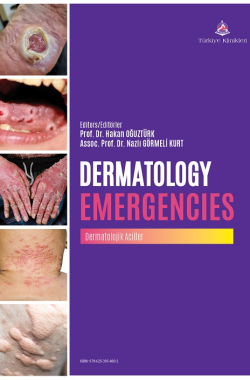Scabies
Orhan Özsoy
Sivas Numune Hospital, Clinic Of Emergency Medicine, Sivas, Türkiye
Sedat Özbay
Sivas Numune Hospital, Clinic Of Emergency Medicine, Sivas, Türkiye
Özsoy o, Özbay S. Scabies. In: oğuztürk H, Görmeli Kurt n, eds. Dermatologic Emergencies. 1st ed. Ankara: türkiye Klinikleri; 2025. p.140-7.
ABSTRACT
Scabies is a contagious skin disease caused by the mite Sarcoptes scabiei var hominis. The main source of transmission is often long-term close contact, while fomite-mediated transmission also plays a role, especially in crusted scabies. Animal-to-human transmission is not observed. It is thought to affect approximately 200 million people worldwide each year. It can affect individuals of all ages. Clinical features include excoriations accompanied by itching that worsens at night and skin lesions that are often papular, but can also be bullous, vesicular or nodular. Demonstration of mites, eggs or feces on the skin is the definitive diagnostic method. Although there are different groupings, classic scabies and crusted scabies are the most common types. The most common complication is secondary skin infections caused by the disruption of skin integrity due to itching. Sepsis and especially death may occur as a result of secondary skin infections, especially in crusted scabies patients. Although it varies between countries, topical permethrin or oral ivermectin constitute the first-line treatment of classic scabies. In the treatment of crusted scabies, permethrin, oral ivermectin and a keratolytic lotion or cream are used together. In endemic regions or institutional outbreak situations, oral ivermectin is a good option due to its ease of use and application. Controlling the transmission and environmental factors, treating individuals in contact, and managing pruritus and complications are important steps in the treatment of scabies.
Keywords: Scabies; mites; pruritus; permethrin; ivermectin
Kaynak Göster
Referanslar
- Thomas c, coates SJ, Engelman d, chosidow o, chang AY. Ectoparasites: Scabies. J Am Acad dermatol. 2020;82(3):533-48. [Crossref] [PubMed]
- Murray rl, crane JS. Scabies. [updated 2023 Jul 31]. In: Statpearls [Internet]. treasure Island (Fl): Statpearls publishing; 2024 Jan-. Available from: [Link]
- Scabies. Accessed August 31, 2024. [Crossref] [PubMed]
- Romani l, Steer Ac, Whitfeld MJ, Kaldor JM. prevalence of scabies and impetigo worldwide: a systematic review. lancet Infect dis. 2015;15(8):960-967. [Crossref] [PubMed]
- Widaty S, Miranda E, cornain EF, rizky lA. Scabies: update on treatment and efforts for prevention and control in highly endemic settings. J Infect dev ctries. 2022;16(2):244-51. [Crossref] [PubMed]
- Sunderkötter c, Wohlrab J, Hamm H. Scabies: Epidemiology, diagnosis, and treatment. dtsch Ärztebl Int. 2021;118(41):695-704. [Crossref] [PubMed] [PMC]
- UYUZ hk.Bilginotu.pdf. Accessed September 1, 2024. [Crossref]
- CDC. About Scabies. Scabies. February 23, 2024. Accessed September 1, 2024. [Link]
- What Is Scabies? cleveland clinic. Accessed September 1, 2024. [Link]
- Heukelbach J, Feldmeier H. Scabies. lancet. 2006;367(9524):1767-74. [Crossref] [PubMed]
- Sharaf MS. Scabies: Immunopathogenesis and pathological changes. parasitol res. 2024;123(3):149. [Crossref] [PubMed] [PMC]
- Kristjansson AK, Smith MK, Gould JW, Gilliam Ac. pink pigtails are a clue for the diagnosis of scabies. J Am Acad dermatol. 2007;57(1):174-5. [Crossref] [PubMed]
- Leung AKc, lam JM, leong KF. Scabies: A neglected Global disease. curr pediatr rev. 2020;16(1):33-42. [Crossref] [PubMed]
- Currie BJ, Mccarthy JS. permethrin and ivermectin for scabies. n Engl J Med. 2010;362(8):717-25. [Crossref] [PubMed]
- CDC. Symptoms of Scabies. parasites - Scabies. January 12, 2024. Accessed September 3, 2024. [Link]
- Chosidow o. Scabies and pediculosis. lancet. 2000;355(9206):819-26. [Crossref] [PubMed]
- Chandler dJ, Fuller lc. A review of Scabies: An Infestation More than Skin deep. dermatology. 2019;235(2):79-90. [Crossref] [PubMed]
- Pomares C, Marty P, delaunay P. Isolated itching of the genitals. Am J trop Med Hyg. 2014;90(4):589-90. [Crossref] [PubMed] [PMC]
- Suh KS, Han SH, lee KH, park JB, Jung SM, Kim St, et al. Mites and burrows are frequently found in nodular scabies by dermoscopy and histopathology. J Am Acad dermatol. 2014;71(5):1022-3. [Crossref] [PubMed]
- Roberts lJ, Huffam SE, Walton SF, currie BJ. crusted scabies: clinical and immunological findings in seventy-eight patients and a review of the literature. J Infect. 2005;50(5):375-81. [Crossref] [PubMed]
- Engelman d, Yoshizumi J, Hay rJ, osti M, Micali G, norton S, et al. the 2020 International Alliance for the control of Scabies consensus criteria for the diagnosis of Scabies. Br J dermatol. 2020;183(5):808-20. [Crossref] [PubMed] [PMC]
- Micheletti rG, dominguez Ar, Wanat KA. Bedside diagnostics in dermatology: parasitic and noninfectious diseases. J Am Acad dermatol. 2017;77(2):221-30. [Crossref] [PubMed]
- Motswaledi HM. clinical diagnosis and treatment of scabies, a neglected tropical disease. S Afr Fam pract (2004). 2021;63(1):e1-e6. [Crossref] [PubMed] [PMC]
- Micali G, lacarrubba F, verzì AE, chosidow o, Schwartz rA. Scabies: Advances in noninvasive diagnosis. ploS negl trop dis. 2016;10(6):e0004691. [Crossref] [PubMed] [PMC]
- Hay rJ, Steer Ac, Engelman d, Walton S. Scabies in the developing world- -its prevalence, complications, and management. clin Microbiol Infect off publ Eur Soc clin Microbiol Infect dis. 2012;18(4):313-23. [Crossref] [PubMed]
- Salavastru cM, chosidow o, Boffa MJ, Janier M, tiplica GS. European guideline for the management of scabies. J Eur Acad dermatol venereol. 2017;31(8):1248-53. [Crossref] [PubMed]
- CDC. clinical care of Scabies. parasites - Scabies. december 18, 2023. Accessed September 8, 2024. [Link]
- Wohlrab J, Staubach p, Augustin M, Eisert l, Hünerbein A, nast A, et al. S2k guidelines for the use of topical preparations on the skin. J dtsch dermatol Ges J Ger Soc dermatol JddG. 2018;16(3):376-92. [Crossref]
- Morgado-carrasco d, piquero-casals J, podlipnik S. tratamiento de la escabiosis [treatment of scabies]. Aten primaria. 2022;54(3):102231. Spanish. [Crossref] [PubMed] [PMC]
- Workowski KA, Bachmann lH, chan pA, Johnston cM, Muzny cA, park I, et al. Sexually transmitted Infections treatment Guidelines, 2021. MMWr recomm rep Morb Mortal Wkly rep recomm rep. 2021;70(4):1-187. [Crossref] [PubMed] [PMC]
- Chambliss Ml. treating asymptomatic bodily contacts of patients with scabies. Arch Fam Med. 2000;9(5):473-4. [Crossref] [PubMed]

